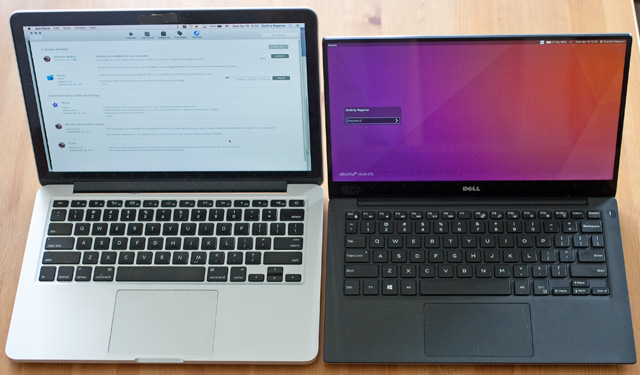Switch from macOS to Linux

(E)migration from macOS to Linux is complete.
Left: early 2013 13 inch MacBook Pro Retina with 2.6 GHz Intel Core i5 running macOS 10.12.4.
Right: early 2017 Dell XPS 13 with 2.7 GHz Intel Core i7-7500 running Ubuntu 16.04.
With Apple reverting to the mean and Microsoft continuing to do nothing, eventual switch to Linux is sadly inevitable. These days the choice seems to be between Dell XPS and Lenovo ThinkPad.
Online reviews are about right. Screen resolution is excellent. Color gamut could be better, but without Photoshop and color calibration tools I don’t plan to do any photo editing on Linux anyway. Coil whine exists but is not a big deal. Keyboard is not as nice as on the MacBook Pro, but passable. Less depth is very nice when working on a train or on a plane. I’m ok with sacrificing some screen height for it.

Most applications work ok with high resolution display, but occasionally I needed to look for a replacement. Printer works out of the box, macOS shares can be connected easily. Some administrative tasks still require command line, GUI alternatives simply hang until I kill them. LibreOffice Calc is much better at mimicking Excel. Chromium, Visual Studio Code, and R Studio just work. VLC has some GUI kinks, but I did not find anything better.
Performance is about the same, despite four years of technological progress. One of my CPU-intensive multithreaded programs completes the same number of Monte-Carlo simulations in 154 minutes on Dell compared to 159 minutes on MacBook Pro. It was compiled with rustc 1.7.0 on Linux and 1.16.0 on macOS.
A similar single-threaded C++ program takes 280 minutes on Dell compared to 190 minutes on MacBook Pro. It was compiled with g++ 5.4.0 on Linux and Apple LLVM 8.0.0 on macOS.